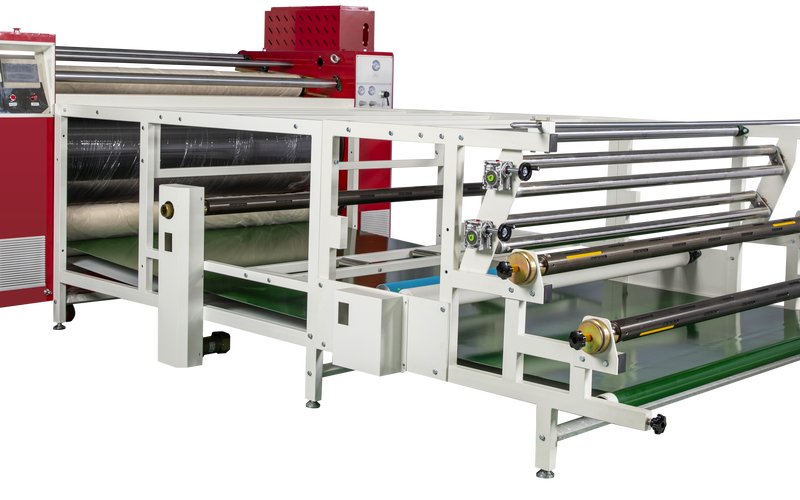
Roll Transfer printing machine
★Current Industry Status
- Technical Characteristics
Roll-to-roll transfer printing machines are high-efficiency, eco-friendly printing equipment that transfer patterns from transfer paper to fabrics (such as polyester, blends, etc.) through heat transfer or digital technology. Key advantages include:- High Precision: Suitable for complex patterns and gradient colors.
- Low Pollution: Compared to traditional printing (e.g., screen printing), it reduces wastewater emissions.
- High Efficiency: Continuous roll-to-roll production, ideal for large-volume orders.
- Market Applications
- Main Sectors: Apparel, home textiles, footwear materials, decorative fabrics, etc.
- Dominant Processes: Thermal sublimation transfer printing leads the market, while digital transfer printing is growing rapidly (especially for small-batch customization).
- Regional Distribution: China, India, and Southeast Asia are major production hubs, while Europe and the U.S. focus on high-end equipment demand.
- Competitive Landscape
- International Brands: Companies from Italy (e.g., MS, JK Group) and Japan (e.g., Toshiba) dominate the high-end market with advanced technology.
- Domestic Players: Manufacturers in Guangdong and Zhejiang (e.g., Honghua Digital, Yuanxin Industrial) compete on cost-performance but still rely on imported core components (e.g., printheads, control systems).
- Industry Challenges: Intense homogenized competition squeezes profits for SMEs; stricter environmental regulations drive technological upgrades.
- Policy and Environmental Requirements
- China’s “dual carbon” goals promote green manufacturing, phasing out high-pollution printing methods and benefiting transfer printing for its low energy consumption and emissions.
- Regulations like EU REACH restrict chemical usage, accelerating R&D in eco-friendly inks (e.g., water-based dyes).
★ Development Prospects
- Growth Drivers
- Fast Fashion Demand: Shorter lead times and personalized orders boost the flexibility of digital transfer printing.
- Sustainable Fashion Trend: Gen Z’s preference for eco-friendly products pushes brands to adopt cleaner production technologies.
- Technological Advancements:
- High-speed digital inkjet (e.g., Single-Pass) reduces production costs;
- AI enhances color calibration and defect detection, improving yield rates.
- Emerging Market Expansion: Growing textile industries in Southeast Asia and Africa drive equipment demand.
- Future Trends
- Digitalization and Smart Manufacturing:
- Industry 4.0 integration (e.g., IoT remote monitoring, automated roll-changing systems);
- Digital printing’s market share is projected to rise from 20% (2023) to over 40% by 2030 (Smithers data).
- Green Technology Breakthroughs:
- Development of biodegradable transfer paper and solvent-free inks;
- Energy recovery (e.g., waste heat utilization) reduces consumption.
- Customization Services:
- Equipment manufacturers transition into “solution providers,” offering integrated design-to-production services.
- Digitalization and Smart Manufacturing:
- Challenges and Risks
- High Initial Investment: Digital equipment (e.g., Single-Pass machines exceeding RMB 10 million) is costly for SMEs.
- Technical Barriers: Core components (e.g., printheads) are monopolized by EPSON and Kyocera; domestic alternatives need time.
- Trade Barriers: Stricter environmental standards in Europe and the U.S. may increase export costs.
★ Conclusion
The roll-to-roll transfer printing machine industry is expected to grow steadily, with a CAGR of 8-10% (2024-2030), driven by digital technology replacing traditional methods. Key strategies for enterprises include:
- Breaking through core technologies (e.g., high-precision printheads, eco-friendly materials);
- Expanding into emerging markets (e.g., Southeast Asia);
- Strengthening sustainable collaborations with apparel brands.
High-Potential Segments: Industrial-grade digital transfer printing equipment, waterless printing technology, AI-driven flexible production systems.
